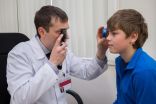(Press-News.org) A new study has found that the occurrence of advanced forms of a diabetic eye disease remains low among children living with diabetes, regardless of how long they have had the disease or their ability to keep blood sugar levels controlled. Researchers are therefore recommending that most children with type 1 diabetes delay annual diabetic retinopathy screenings until age 15, or 5 years after their diabetes diagnosis, whichever occurs later. Their findings were published online today in Ophthalmology, the journal of the American Academy of Ophthalmology.
It is well established that early detection and timely treatment of diabetic retinopathy reduces vision loss in adults, and some physician organizations recommend screening children for diabetic retinopathy annually starting at an early age - after age 9, or from 3 to 5 years after diagnosis. However, the value of screening children has not been clearly documented and the prevalence of severe diabetic retinopathy among the young has been unclear.
Researchers based at The Children's Hospital of Philadelphia and the Scheie Eye Institute, Perelman School of Medicine at the University of Pennsylvania began to question current diabetic retinopathy screening guidelines for children. They were concerned that these annual exams may create an excessive financial and logistical burden for families and the health care system.
The researchers conducted a retrospective study of 370 children under age 18 with type 1 and type 2 diabetes. Some of the study participants had blood sugar levels three times that of a person without diabetes. All had received at least one diabetic eye disease screening exam between 2009 and 2013, but none were found to have diabetic retinopathy.
The researchers then examined the data that led to the current screening guidelines. They discovered that previous studies reported a diabetic retinopathy prevalence rate between 0 and 28 percent among children studied, but the majority of the cases were very mild and thus would not qualify for treatment. They also found that the youngest person reported to have severe diabetic retinopathy was between 15 and 19 years old, and 5 to 6 years was the shortest reported duration of having diabetes before developing severe diabetic retinopathy.
In light of the available evidence, the researchers recommend that screenings for children with type 1 diabetes could begin at a later age than previously recommended.
"Many of our young patients with diabetes diligently come in every year for screenings that consistently show no sign of the disease," said Gil Binenbaum, M.D., M.S.C.E., co-author of the study and attending surgeon in the ophthalmology division at The Children's Hospital of Philadelphia. "Of course, that's good news for them, and it is very important to have annual eye exams once the risk of vision loss develops. But, is it worth the burden on the family and the healthcare system if evidence shows that diabetic retinopathy doesn't reach a treatable stage until years later?"
Researchers say exceptions should be made for children with type 2 diabetes and those identified by their endocrinologists as having high risk for diabetic complications. They should start diabetic retinopathy screenings upon diagnosis, similar to adults with type 2 diabetes, since many type 2 diabetes patients live with the disease uncontrolled before they are diagnosed. Because there is limited published researched on children with type 2 diabetes and diabetic retinopathy, researchers noted that a retinopathy screening examination upon diagnosis is their recommendation for those patients until additional data showing otherwise is available.
Diabetic retinopathy is the leading cause of blindness among working-age adults in the United States and affects close to 8 million people. The American Academy of Ophthalmology currently recommends that people with type 1 diabetes have annual screenings for diabetic retinopathy beginning 5 years after the onset of their disease, and that those with type 2 diabetes should have an examination at the time of diagnosis and at least once a year thereafter.
INFORMATION:
About the American Academy of Ophthalmology
The American Academy of Ophthalmology, headquartered in San Francisco, is the world's largest association of eye physicians and surgeons, serving more than 32,000 members worldwide. The Academy's mission is to advance the lifelong learning and professional interests of ophthalmologists to ensure that the public can obtain the best possible eye care. For more information, visit http://www.aao.org.
The Academy is also a leading provider of eye care information to the public. The Academy's EyeSmart® program educates the public about the importance of eye health and empowers them to preserve healthy vision. EyeSmart provides the most trusted and medically accurate information about eye diseases, conditions and injuries. OjosSanos™ is the Spanish-language version of the program. Visit http://www.geteyesmart.org or http://www.ojossanos.org to learn more.
About Ophthalmology
Ophthalmology, the official journal of the American Academy of Ophthalmology, publishes original, peer-reviewed, clinically-applicable research. Topics include the results of clinical trials, new diagnostic and surgical techniques, treatment methods, technology assessments, translational science reviews and editorials. For more information, visit http://www.aaojournal.org.
A bacterium engineered to produce different pigments in response to varying levels of a micronutrient in blood samples could give health officials an inexpensive way to detect nutritional deficiencies in resource-limited areas of the world. This "bacterial litmus test," which currently measures levels of zinc, would require no electrical equipment and make results visible as simple color changes.
More than a billion people worldwide may be at risk for adequate zinc intake, but measuring zinc levels in blood samples currently requires sophisticated testing equipment not ...
In the "NeverEnding Story", Bastian feels so involved in the narration that he experiences the same emotions as the characters (and in the end he really enters the book). What happens to the main character of Micheal Ende's book is exactly what happens to each of us when we read a novel or a short story: we literally replicate the physiological processes and emotions of the characters described in the text. Francesco Foroni, research scientist at the International School for Advanced Studies (SISSA) of Trieste, already demonstrated this phenomenon a few years ago in a study ...
PULLMAN, Wash.--Washington State University researchers have found that the timing of an animal's sleep can be just as important as how much sleeps it gets.
Ilia Karatsoreos, an assistant professor in WSU's Department of Integrative Physiology and Neuroscience, shifted mice from their usual cycle of sleeping and waking and saw that, while they got enough sleep, it was of poorer quality. The animals also had a disrupted immune response, leaving them more open to illness.
Most sleep research focuses on the effects of sleep deprivation or the overall amount of sleep an animal ...
A multi-disciplinary group of European researchers spanning natural science, socio-economics and law have joined forces to assess the current landscape of deep-sea research and investment in Europe. Once considered remote and inaccessible, commercial interest to exploit the deep sea (1) is rising due to economic drivers and technology developments. However, exploitation activities in the deep sea remain highly contentious, particularly regarding the potential risks and environmental impacts associated with such activities. A consultation of deep-sea stakeholders spanning ...
New research from LSTM has revealed precisely how insecticide-treated bed nets are so effective against malaria mosquitoes.
Communities in the poorest countries are the most vulnerable to malaria and 90% of all malaria deaths occur in Africa. Safe, simple and affordable, long-lasting insecticidal bed nets (LLINs) are very effective in preventing malaria and have played a major part in reducing malaria deaths in Africa by over 50% since 2000 (WHO). However, as very little is known about how mosquitoes interact with nets or how LLINs do their job so effectively, how they ...
Researchers at University of La Rioja (Spain) have developed a new method to eliminate artificial satellites in Highly Elliptical Orbits when they finish their mission. The methodology, which allows for a reduction of both cost and risk, has been tested with the European Space Agency INTEGRAL mission, which will re-enter into the Earth's atmosphere in order to disintegrate in 2029.
The problem of space debris is one of the main challenges that aerospace engineers have to face, due to the danger it poses to satellites. In this context, members of the Scientific Computing ...
BEIJING, CHINA (1 September 2015)--At a time when the price of mutton is climbing and wool crashing, a groundbreaking new study has used advanced genetic sequencing technology to rewrite the history of sheep breeding and trading along the ancient Silk Road--insights that can help contemporary herders in developing countries preserve or recover valuable traits crucial to their food and economic security.
The new findings regarding one of the first animals ever domesticated will be published in the October print edition of the journal Molecular Biology and Evolution. They ...
DENVER (Sept. 1, 2015) - While many planners focus on the threat of natural disasters to major metropolises around the world, a new study from the University of Colorado Denver shows smaller cities are often even less equipped to handle such catastrophes.
"Small cities are often far away from where decisions get made and struggle to insert themselves into the agenda of decision-making bodies," said study author Andrew Rumbach, PhD, an assistant professor at the CU Denver College of Architecture and Planning, a major center of timely, topical and relevant research. "When ...
The unique properties found in the stunning iridescent wings of a tropical blue butterfly could hold the key to developing new highly selective gas detection sensors.
Pioneering new research by a team of international scientists, including researchers from the University of Exeter, has replicated the surface chemistry found in the iridescent scales of the Morpho butterfly to create an innovative gas sensor.
The ground-breaking findings could help inspire new designs for sensors that could be used in a range of sectors, including medical diagnostics, industry, and the ...
A team of researchers led by scientists at the National Geospatial-Intelligence Agency published a new map Sept. 1 that characterizes the Earth's radioactivity and offers new and potential future applications for basic science research and nonproliferation efforts.
The Antineutrino Global Map 2015, or AGM2015, is an unprecedented experimentally-informed model of the Earth's natural and manmade antineutrino flux.
The map uses open-source geophysical data sets and publicly available international antineutrino detection observational data to depict varying levels of radioactivity ...


